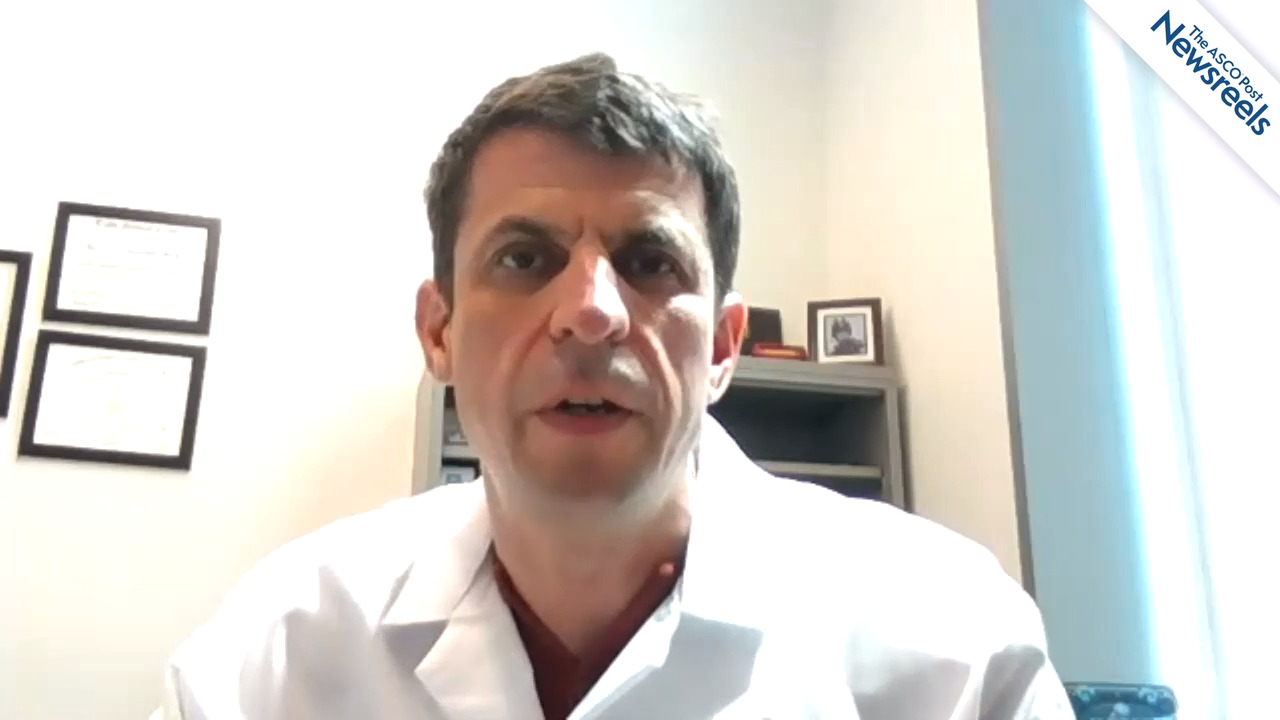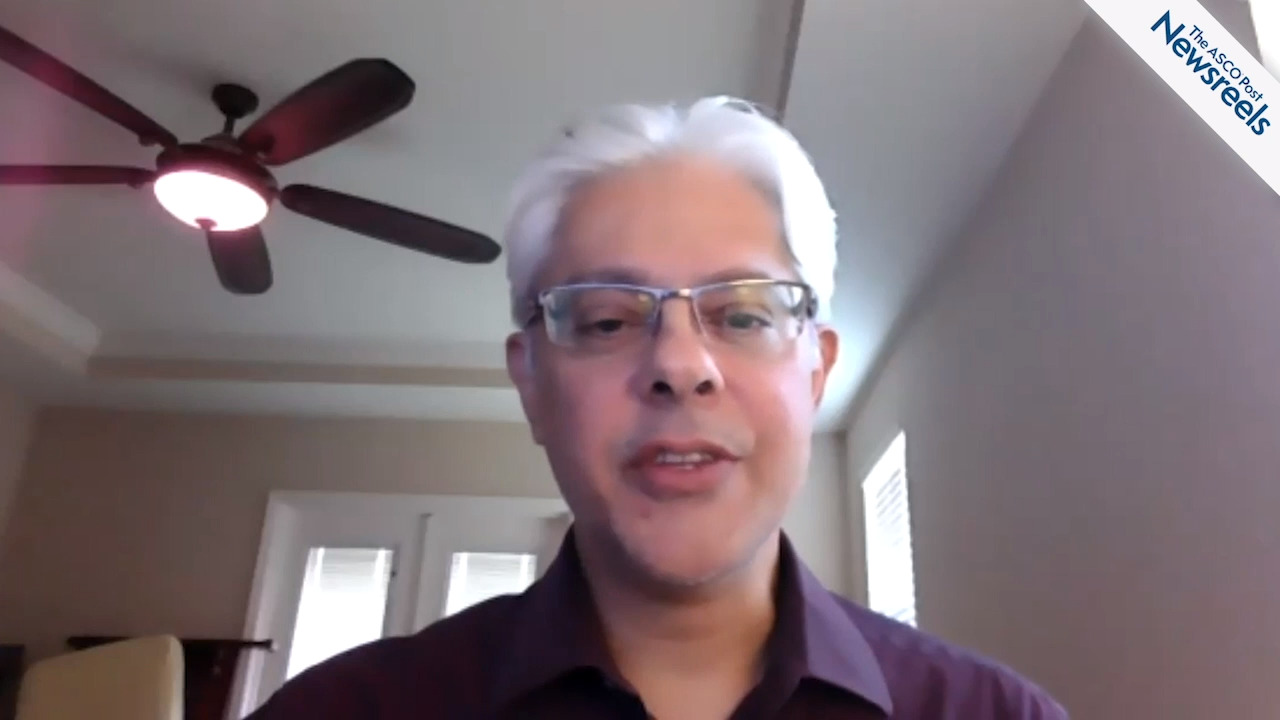Addition of Enasidenib to Azacitidine in Newly Diagnosed IDH2-Mutant Acute Myeloid Leukemia
As reported in The Lancet Oncology by Courtney D. DiNardo, MD, and colleagues, an interim analysis of the phase II portion of a phase Ib/II trial (AG221-AML-005) showed that the addition of the oral mutant IDH2 protein inhibitor enasidenib to azacitidine significantly improved overall response rate ...
Noninferior Progression-Free Survival and Reduced Cardiovascular Toxicity With Acalabrutinib vs Ibrutinib in Previously Treated CLL
As reported in the Journal of Clinical Oncology by John C. Byrd, MD, of The Ohio State University Comprehensive Cancer Center, and colleagues, the phase III ELEVATE-RR trial has shown noninferior progression-free survival with the more-selective Bruton’s tyrosine kinase (BTK) inhibitor...
BTK Inhibition in CLL: An Embarrassment of Riches
Chronic lymphocytic leukemia (CLL) is a B-cell lymphoproliferative disorder defined by a specific phenotype and the presence of more than 5,000 clonal B cells in the peripheral blood.1 In the absence of this number of circulating cells, its soft-tissue/bone-marrow counterpart is semantically...
Ibrutinib vs Placebo Following Achievement of Undetectable MRD With First-Line Ibrutinib/Venetoclax in CLL
As reported in the Journal of Clinical Oncology by William G. Wierda, MD, PhD, and colleagues, findings in the measurable residual disease (MRD) cohort of the phase II CAPTIVATE study indicated a high disease-free survival rate with placebo and no significant benefit of continued ibrutinib in...
A Look at Tomorrow’s CAR T-Cell Therapy Today
Some of the most impressive data on chimeric antigen receptor (CAR) T-cell therapy have come from studies conducted in China. Attendees at the 2021 Pan Pacific Lymphoma Conference heard from one of the leading Chinese investigators, Peihua (Peggy) Lu, MD, of Lu Daopei Hospital, who described the...
FDA Approves Brexucabtagene Autoleucel for Relapsed or Refractory B-Cell Precursor ALL
On October 1, the U.S. Food and Drug Administration (FDA) approved brexucabtagene autoleucel (Tecartus), a CD19-directed chimeric antigen receptor (CAR) T-cell therapy, for adult patients with relapsed or refractory B-cell precursor acute lymphoblastic leukemia (ALL). ZUMA-3 Efficacy was evaluated ...
Luis E. Aguirre, MD, on Chronic Myelomonocytic Leukemia: Keys to Assessment and Treatment
Luis E. Aguirre, MD, of the H. Lee Moffitt Cancer Center and Research Institute, discusses the subset of patients with chronic myelomonocytic leukemia who have a more indolent disease course. Features at diagnosis may include higher hemoglobin and platelet counts or JAK2, SF3B1, and IDH2 mutations; features associated with earlier initiation of treatment may include an elevated white blood cell count or a higher number of marrow blasts. Identifying the changes that occur between diagnosis and treatment are among future research goals (Abstract MDS-229).
Study Finds Genetic Predisposition to Higher Lymphocyte Production May Lead to Higher ALL Risk
Research published by Kachuri et al in the American Journal of Human Genetics reveals that children born with a genetic predisposition to produce more lymphocytes—particularly in relation to other types of white blood cells—may be at a higher risk of developing acute lymphoblastic leukemia (ALL)....
First-Line Acalabrutinib, Venetoclax, and Obinutuzumab for Chronic Lymphocytic Leukemia
In a phase II study reported in The Lancet Oncology, Matthew S. Davids, MD, and colleagues found that first-line triple combination therapy with acalabrutinib, venetoclax, and obinutuzumab produced measurable residual disease (MRD)-negative complete remission in a substantial proportion of patients ...
Fixed-Dose, First-Line Ibrutinib/Venetoclax Combination Achieves Durable Remissions in CLL
The combination of fixed-duration, first-line treatment with ibrutinib plus venetoclax achieved complete responses in more than half of patients with chronic lymphocytic leukemia (CLL)/small lymphocytic leukemia (SLL), based on the primary analysis of the fixed-dose cohort of the phase II CAPTIVATE ...
ELEVATE-RR Trial: Acalabrutinib as Effective as Ibrutinib, With Fewer Cardiac Effects, in Resistant CLL
Acalabrutinib was equally efficacious with less toxicity when compared directly with ibrutinib in patients with previously treated relapsed or refractory chronic lymphocytic leukemia (CLL), according to the results of an open-label, randomized, noninferiority phase III trial presented at the 2021...
Curtis Lachowiez, MD, on AML: Venetoclax Combined With FLAG-IDA
Curtis Lachowiez, MD, of The University of Texas MD Anderson Cancer Center, discusses data that show combining venetoclax with FLAG-IDA chemotherapy to treat patients with newly diagnosed acute myeloid leukemia led to minimal residual disease negativity in more than 90% of those achieving a composite complete response (Abstract AML-024).
AUTO1: CAR T-Cell Product for Adult Patients With Relapsed or Refractory B-Cell ALL
In a phase I trial (ALLCAR19) reported in the Journal of Clinical Oncology, Roddie et al found that the fast off-rate autologous CD19 chimeric antigen receptor (CAR) T-cell therapy CAT19-41BB-Z—also known as AUTO1—was well tolerated and produced high remission rates in adults with relapsed or...
ELEVATE-RR Trial: Acalabrutinib as Effective as Ibrutinib, With Fewer Cardiac Effects, in Resistant CLL
Acalabrutinib was equally efficacious with less toxicity when compared directly with ibrutinib in patients with previously treated relapsed or refractory chronic lymphocytic leukemia (CLL), according to the results of an open-label, randomized, noninferiority phase III trial presented at the 2021...
Ibrutinib and Cardiovascular Risk in Patients With Chronic Lymphocytic Leukemia
In a Canadian population-based cohort study reported in the Journal of Clinical Oncology, Abdel-Qadir et al found that ibrutinib treatment for chronic lymphocytic leukemia (CLL) is associated with increased risks of atrial fibrillation, bleeding, and heart failure, but not ischemic stroke or acute...
Study Suggests Demographic Enrollment Reporting Requirements for Acute Leukemia Clinical Trials Are Lacking
Requirements instituted to address racial and ethnic disparities in clinical trial enrollment did not lead to increased inclusion of Black and Hispanic participants in clinical acute leukemia research, according to a new study published by Andrew Hantel, MD, and colleagues in the journal Blood...
Effect of Concurrent Focal 22q11.22 Deletions and IKZF1 Alterations on Outcomes in Pediatric Patients With B-Cell ALL
In a study reported in JAMA Oncology, Mangum et al found that focal deletions in chromosome 22q11.22 were associated with poor outcomes in pediatric patients with B-cell acute lymphoblastic leukemia (ALL) with IKZF1 alterations. As stated by the investigators, “Alterations in the IKZF1 gene drive...
Study Explores Relationship Between Anti-CD20 Therapy and Reduced Responses to mRNA COVID-19 Vaccines
Patients with lymphoma or other lymphoid cancers should continue to take steps to protect themselves from COVID-19 even if they have been vaccinated against the disease, a new study by Jennifer Crombie, MD, and colleagues published in Blood Advances suggests. The study found that patients who had...
Outcomes Notably Improving for Adult ALL
Outcomes in adults with acute lymphoblastic leukemia (ALL) are almost rivaling those in pediatric ALL, thanks to the benefits achieved by incorporating blinatumomab and inotuzumab into chemotherapy regimens. New ways of administering the chemotherapy component are also increasing tolerability and...
Study Identifies Possible New Genetic Biomarkers of Pediatric Leukemia
In a study published by Magnum et al in JAMA Oncology, researchers reported on how two separate DNA changes appear to predict aggressive childhood leukemias when they occur in combination. The team evaluated tumor characteristics of more than 1,300 pediatric patients with B-cell acute lymphoblastic ...
Donor-Derived CD7 CAR T Cells May Lead to Remissions in Patients With Relapsed or Refractory T-ALL
In a Chinese single-institution phase I study reported in the Journal of Clinical Oncology, Pan et al found that donor-derived CD7 chimeric antigen receptor (CAR) T-cell therapy produced a high complete remission rate in patients with relapsed or refractory T-cell acute lymphoblastic leukemia...
Experimental Small-Molecule Inhibitor May Improve Responses to Cellular Therapies in Advanced CLL
Too many “exhausted” T cells left in the wake of aggressive chemotherapy regimens for patients with advanced chronic lymphocytic leukemia (CLL) make it more challenging for chimeric antigen receptor (CAR) T-cell therapy to do its job. Now, a new study from researchers at the Perelman School of...
Alexey V. Danilov, MD, PhD, on Lymphoid Malignancies: Novel Agents Targeting BTK Inhibitor–Resistant Disease
Alexey V. Danilov, MD, PhD, of City of Hope, discusses the uses and side effects of cellular and immune therapies, including venetoclax and obinutuzumab, which may prove to be effective in treating highly resistant lymphoid malignancies such as chronic lymphocytic leukemia.
FDA Pipeline: Reviews for Agents in Lung Cancer, Thyroid Cancer, Kidney Cancer, and More
Recently, the U.S. Food and Drug Administration (FDA) accepted applications for agents aiming to treat non–small cell lung cancer (NSCLC), differentiated thyroid cancer, renal cell carcinoma (RCC), hypersensitive acute lymphoblastic leukemia (ALL), mucosal melanoma, and endometrial carcinoma....
Asparaginase Erwinia Chrysanthemi (Recombinant)-rywn for Acute Lymphoblastic Leukemia and Lymphoblastic Lymphoma
On June 30, 2021, asparaginase erwinia chrysanthemi (recombinant)-rywn was approved as a component of a multiagent chemotherapeutic regimen for treatment of acute lymphoblastic leukemia (ALL) and lymphoblastic lymphoma in adult and pediatric patients 1 month or older who have developed...
Expert Point of View: Jacqueline C. Barrientos, MD, MS
The ASCO Post invited Jacqueline C. Barrientos, MD, MS, Associate Professor of Medicine, CLL Research and Treatment Program, Zucker School of Medicine at Hofstra/Northwell, Lake Success, New York, to comment on the ALPINE findings presented at the European Hematology Association (EHA) Virtual...
Zanubrutinib Superior to Ibrutinib for CLL/SLL in Phase III ALPINE Trial
Zanubrutinib, a second-generation Bruton’s tyrosine kinase (BTK) inhibitor, significantly improved response rates and delayed disease progression as compared with the standard of care, ibrutinib, in patients with relapsed or refractory chronic lymphocytic leukemia or small lymphocytic lymphoma...
ELEVATE-RR Trial: Acalabrutinib vs Ibrutinib in Previously Treated Patients With CLL
As reported in the Journal of Clinical Oncology by John C. Byrd, MD, and colleagues, the phase III ELEVATE-RR trial has shown noninferior progression-free survival with the more selective Bruton’s tyrosine kinase (BTK) inhibitor acalabrutinib vs the less selective inhibitor ibrutinib in previously...
Expert Point of View: Guru Subramanian Guru Murthy
Invited discussant Guru Subramanian Guru Murthy, MD, MS, of the Medical College of Wisconsin, Milwaukee, commented on the study of aspacytarabine in the first-line therapy for patients with acute myeloid leukemia (AML) unfit for standard chemotherapy. “This study elegantly highlights there is still ...
Study Finds Cytarabine Prodrug Active and Safe in Older Compromised Patients With AML
Aspacytarabine, a cytarabine prodrug, was reported to be safe and effective as first-line therapy for patients with acute myeloid leukemia (AML) who were unfit for intensive induction chemotherapy, according to the results of a phase II study presented during the 2021 ASCO Annual Meeting.1 The...
Pulsed Vincristine/Dexamethasone Maintenance in Pediatric Acute Lymphoblastic Leukemia
In a Chinese phase III trial (CCCG-ALL-2015) reported in The Lancet Oncology, Yang et al found that 1 year of maintenance therapy with pulsed vincristine and dexamethasone was noninferior to 2 years in low-risk pediatric patients with acute lymphoblastic leukemia and was borderline inferior in...
Can Treatment With Thiopurines Induce Mutations That May Lead to Pediatric Leukemia Relapse?
Chemotherapy has helped make acute lymphoblastic leukemia (ALL) one of the most survivable childhood cancers. Now, a research team has shown how thiopurines may lead to mutations that set patients up for disease relapse. These findings were published by Yang et al in Nature Cancer. The research...
B-Cell Acute Lymphoblastic Leukemia: Update on Clinical Trials
“Learning never exhausts the mind.” —Leonardo da Vinci To complement The ASCO Post’s continued comprehensive coverage of the 2020 American Society of Hematology (ASH) Annual Meeting & Exposition, here are several abstracts selected from the meeting proceedings focusing on treatments under study ...
Phase III GLOW Trial: Improved Outcomes With First-Line Ibrutinib Plus Venetoclax in Elderly Patients With CLL
Fixed-duration ibrutinib and venetoclax as a first-line treatment yielded superior outcomes compared with chlorambucil plus obinutuzumab in patients with chronic lymphocytic leukemia (CLL), based on the primary analysis of the phase III GLOW trial presented during the European Hematology...
Combination Ficlatuzumab and Cytarabine Show Clinical Activity in Relapsed/Refractory AML
Despite advances in the treatment of acute myeloid leukemia (AML), only 29.5% of patients with the cancer are alive 5 years after diagnosis. Even with aggressive therapy, just 30% of patients achieve a complete remission with a median survival of 7.5 months, making it imperative to develop novel...
Calaspargase Pegol vs Pegaspargase in Pediatric ALL
In a phase III trial (DFCI 11-001) reported in the Journal of Clinical Oncology, Vrooman et al found that the novel pegylated asparaginase formulation calaspargase pegol (calaspargase) given every 3 weeks was associated with similar serum asparaginase activity nadir values, survival outcomes, and...
Being Both a Cancer Provider and a Cancer Survivor Is a Rare Privilege
Perhaps my 35-year career as a surgical oncologist and researcher specializing in soft-tissue sarcomas should have prepared me to recognize the signs of chronic lymphocytic leukemia (CLL) when they first appeared a few days before Christmas in 2016, but it did not. In fact, my symptoms were so...
Expert Point of View: Jacqueline C. Barrientos, MD
The invited discussant of the phase I trial of lisaftoclax (APG-2575), Jacqueline C. Barrientos, MD, of Hofstra/Northwell, Great Neck, New York, commented on the positive findings: “The 15 patients with chronic lymphocytic leukemia [CLL] had an objective response rate of 80% and a median time to...
Novel BCL2 Inhibitor Shows Activity in CLL in Phase I Trial
The novel, selective BCL2 inhibitor lisaftoclax (APG-2575) has shown activity in the treatment of relapsed or refractory chronic lymphocytic leukemia (CLL) in a phase I study reported at the 2021 ASCO Annual Meeting.1 Preliminary data suggest that lisaftoclax stands out for its favorable safety...
Expert Point of View: Jacqueline C. Barrientos, MD, MS
Invited discussant Jacqueline C. Barrientos, MD, MS, of Northwell Health Cancer Institute, Zucker School of Medicine at Hofstra/Northwell in Great Neck, New York, noted that, although both ibrutinib and venetoclax have shown superior results to chemotherapy, each drug is associated with toxicity....
Fixed-Dose, First-Line Ibrutinib/Venetoclax Combination Achieves Durable Remissions in CLL
The combination of fixed-duration, first-line treatment with ibrutinib plus venetoclax achieved complete responses in more than half of patients with chronic lymphocytic leukemia (CLL)/small lymphocytic leukemia (SLL), based on the primary analysis of the fixed-dose cohort of the phase II CAPTIVATE ...
Arsenic Plus All-Trans Retinoic Acid for Pediatric Patients With Acute Promyelocytic Leukemia
In a Chinese study (CCLG-APL2016) reported in the Journal of Clinical Oncology, Zheng et al found that the combination of arsenic with all-trans retinoic acid (ATRA) was associated with good survival outcomes in pediatric patients with acute promyelocytic leukemia. Study Details The multicenter...
Humanized CD19-Targeted CAR T-Cell Treatment in Patients With Relapsed or Refractory B-Cell ALL
In a pilot study reported by Myers et al in the Journal of Clinical Oncology, a humanized CD19-targeted chimeric antigen receptor (CAR) T-cell product developed by the investigators (huCART19) was found to produce durable remissions and prolonged CAR T-cell persistence in CAR-naive and CAR-exposed...
Effect of Myeloid Progenitor Cell Product on the Risk of Infection During Induction Chemotherapy for AML
In a phase II trial reported in the Journal of Clinical Oncology, Desai et al found that the addition of the myeloid progenitor cell product romyelocel-L to granulocyte colony-stimulating factor (G-CSF) reduced the incidence of infection and antimicrobial use vs G-CSF alone during induction...
Lessons From Pneumococcal Vaccine Responses in Patients With CLL in an Evolving Vaccine Landscape
The role of vaccines in mitigating the significant morbidity and mortality associated with infections in chronic lymphocytic leukemia (CLL) is a developing field of study, punctuated by the advent of novel therapeutic agents and pressing questions regarding the global SARS–CoV-2 vaccination...
Low Response Rates to Conjugate Pneumococcal Vaccine in Patients With Chronic Lymphocytic Leukemia
In an Italian study reported in Leukemia, Francesca Romana Mauro, MD, of the Department of Translational and Precision Medicine, Sapienza University, Rome, and colleagues found that only a small minority of patients with chronic lymphocytic leukemia (CLL) developed an adequate immune response to...
Martin Kaiser, MD, on Myeloma and Plasma Cell Leukemia: Transplantation Plus Daratumumab/CVRD Therapy
Martin Kaiser, MD, of The Institute of Cancer Research and Royal Marsden Hospital, discusses findings from the UK OPTIMUM/MUKNINE trial on the depth of response and minimal residual disease status in patients with ultra-high–risk newly diagnosed multiple myeloma and plasma cell leukemia who were treated with augmented autologous transplant and daratumumab plus cyclophosphamide, bortezomib, lenalidomide, and dexamethasone (Abstract S181).
Bijal D. Shah, MD, on CLL: CAR T-Cell Therapy With Brexucabtagene Autoleucel
Bijal D. Shah, MD, of the H. Lee Moffitt Cancer Center, discusses phase II results of the ZUMA-3 study, which evaluated brexucabtagene autoleucel (KTE-X19), an anti-CD19 CAR T-cell therapy, in adults with relapsed or refractory B-cell acute lymphoblastic leukemia (Abstract 7002).
Paolo Ghia, MD, PhD, on CLL/SLL and Ibrutinib Plus Venetoclax: A Primary Analysis of the CAPTIVATE Trial
Paolo Ghia, MD, PhD, of the Università Vita-Salute San Raffaele, discusses phase II results from the CAPTIVATE study, which examined ibrutinib plus venetoclax as a fixed-duration first-line treatment in patients with chronic lymphocytic leukemia/small lymphocytic lymphoma (Abstract 7501).
Brexucabtagene Autoleucel in Adults With Relapsed or Refractory B-Cell ALL: ZUMA-3
As reported in The Lancet by Shah et al, the pivotal phase II ZUMA-3 trial has shown a high rate of complete remission with the autologous anti-CD19 chimeric antigen receptor (CAR) T-cell therapy brexucabtagene autoleucel (formerly KTE-X19) in adults with relapsed or refractory B-cell acute...






